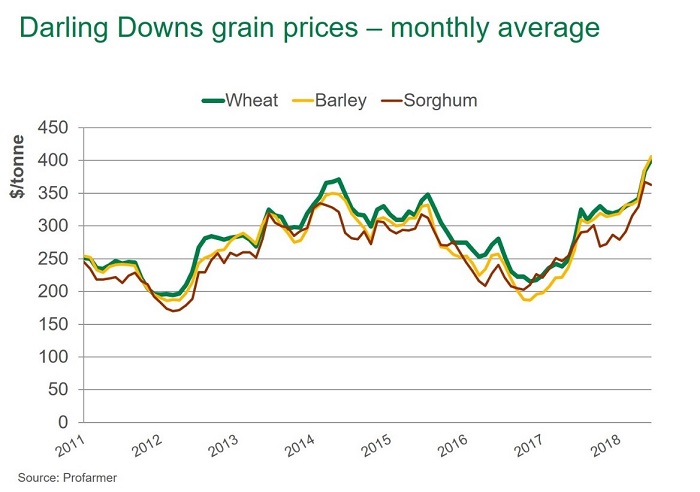Market watch: cattle on feed
With cattle on feed exceeding one million head and ongoing dry conditions, prices for wheat and barley have hit their highest level in almost ten years.
Feedlot Sector
Cattle on feed exceeded one million head for the first time in the March quarter 2017, which was again the case in March 2018 despite significantly higher feed grain prices. During the March quarter 2017, Darling Downs wheat averaged $234/tonne, compared to $329/tonne in the March quarter 2018 – representing an increase of 40%.
Despite the surge in feed grain prices, cattle on feed numbers will likely remain close to historically high levels, supported by robust grainfed beef demand and the sustained dry throughout the June quarter.
The national feeder steer indicator has continued to decline since the March quarter, averaging 276A¢/kg live weight in June, 20% lower year-on-year. Falls in feeder cattle prices have been offset by higher grain prices. However, lot feeders have seen relatively stable prices for finished cattle, as the QLD 100-day grainfed steer over-the-hook (OTH) indicator has only declined 4A¢/kg cwt since March, averaging 518A¢/kg cwt in June.
Feed grain price
Feed grain prices become increasingly relevant to Australian livestock markets in dry times. As pasture availability declines along with restocker demand, producers look to the growing lot-feeding sector to absorb any excess supply of livestock.
Demand for feed grain continues to rise, with prices for wheat and barley at their highest level in almost ten years. For the first few weeks of June, wheat delivered Darling Downs averaged $401/tonne, up 48% from the same period last year, while barley increased 60% to $406/tonne (Profarmer). Wheat delivered Goulburn Valley was 50% higher year-on-year, averaging $322/tonne in June so far, and barley was up 62%, to $307/tonne.

Winter crop outlook
ABARES have released their winter crop outlook for 2018-19 – a quarterly report that assesses crop condition and the forecasts of area, yield and production for Australia’s major field crops.
The beginning of the 2018-19 winter crop season varied across the country. Rainfall during autumn was mostly below average, although cropping regions in WA, SA, Victoria and southern NSW received some well-timed rainfall in May, which assisted sowing of winter crops. Most cropping regions of Queensland and northern NSW, however, remained dry – hindering planting in these areas. At the end of autumn, lower layer soil moisture across most cropping regions were ‘below’ to ‘very much below’ average – meaning adequate winter rainfall will be critical for crop development.
According to the latest three-month rainfall outlook from the Bureau of Meteorology, WA has an approximate 50% chance of receiving average rainfall during winter, while the south-east mainland is likely to be drier than average over the outlook period.
The total area planted to winter crops is forecast to be 4% lower overall, to 21.1 million hectares – due to decreased areas across NSW, Queensland and WA. Higher prices for cereal feed grains, compared to oilseeds and pulses, are likely to see a greater area planted to barley, and a reduction in area planted to canola and legumes.
ABARES report that the area planted to wheat is forecast to ease 2%, to 12 million hectares, while the area to barley is predicted to grow by 10%, to 4.3 million hectares.
Assuming average winter rainfall arrives, winter crop production is expected to be down slightly to 37.7 million tonnes. Wheat production is forecast to lift 3% to 21.9 million tonnes and barley is forecast to increase 3% to 9.2 million tonnes. Offsetting these increases, canola production is predicted to be 16% lower, at 3.1 million tonnes, chickpea production is expected to decline 40%, and oats production is forecast to remain similar, at 1.1 million tonnes.
More information
For more information on the ABARES winter crop outlook, visit the ABARES website.



